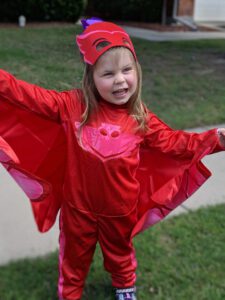Halloween can be a super fun holiday, but for kids with autism or sensory issues, wearing a costume can feel uncomfortable. Some costumes have itchy fabric, tight masks, or even strange smells. Here are some tips to help your child feel comfortable and excited about their Halloween costume this year!
1. Start Early
- Get the costume early so your child has time to get used to it.
- Let them look at the costume, touch it, and even play with it. This way, it won’t feel new or scary on Halloween.
2. Let Them Help Pick the Costume
- Take your child shopping for costumes, or let them pick from a few options.
- Choosing a costume they like can make them feel excited to wear it.
- Make sure it’s something that feels comfortable, like soft fabrics or costumes without masks if they don’t like things on their face.
3. Practice Wearing the Costume
- Have your child try on their costume a few times before Halloween.
- Start with short amounts of time, like 5 or 10 minutes. Gradually make it longer each time.
- Praise them for trying it on, even if it’s just for a few minutes. Say things like, “You look awesome!” or “Wow, you’re doing a great job!”
4. Make Adjustments for Comfort
- If parts of the costume feel scratchy, try wearing a soft shirt or leggings underneath.
- You can cut off tags or use scissors to remove any itchy parts.
- If they don’t like masks, consider face paint or hats instead. Find ways to make the costume work for your child’s needs!
5. Create a Story Around the Costume
- Pretend to be their character with them! Tell stories about what their character does.
- For example, if they’re dressing up as a superhero, you can pretend to go on a “mission” around the house.
- This can help them feel excited about wearing the costume because they get to “become” someone fun.
6. Practice Walking Around in the Costume
- Once they’re used to wearing the costume, have them walk around in it.
- Practice things they might do on Halloween, like saying “trick or treat!” and holding a candy bag.
- Try walking to the end of the driveway or around the yard. This practice can make Halloween night feel more familiar and comfortable.
7. Bring a Backup Outfit
- It’s always a good idea to have a backup outfit, like a favorite sweatshirt or comfy clothes, just in case.
- If your child decides they don’t want to wear the costume anymore, they can still have a great time in something they love.
Halloween can be a fun time for everyone, and with a little planning, you can help your child enjoy dressing up! Remember, go at their pace, and let them know it’s okay to take breaks. Most importantly, have fun and celebrate all the little successes along the way. Happy Halloween! 🎃

